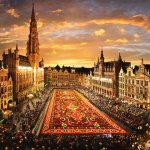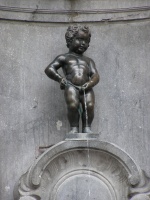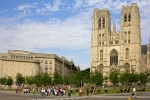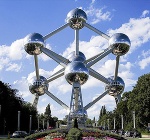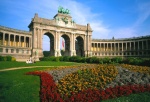World Tour: Brussels, Belgium
Author: Sailea Nerid

Brussels, also known as Bruxelles in French and Brussel in Dutch, is the capital of the little but important state of Belgium. As you could probably see from my first sentence it’s a rather multicultural/ multilingual place. The magnificent city you see today used to be a 10th-century fortress town founded by a descendant of Charlemagne. Its population is about 1.2 million people today. You should know that the official languages in Belgium are Dutch, French, and German but you will find most signs written in French and Dutch. The good news is that almost everyone speaks English.
The climate is oceanic and there are about 200 days of rain per year so when you pack do not forget an umbrella. If the weather upsets you greatly you can always run away to another city using the very fine train network. You are just 1hr 50 min away from London and Amsterdam, 1hr and 25 min from Paris, and 3h from Frankfurt. Still be sure you try the local cuisine that some people define as a combination of French cuisine with the more hearty Flemish fare. Numerous friteries are spread throughout the city offering French fries and other bad-for-your-cholesterol delights. Fresh, hot, waffles are also sold on the street. Do not forget to try the chocolate and the beer too. I guarantee that you would not be disappointed.
Now, here are some places you should definitely visit during your stay in the capital of the European Union.
Grand Place (Grote Markt)
This is the central plaza of Brussels. The buildings are in the Baroque style but with some Flemish influences with their magnificent ornately carved stonework, and rich gold decoration. Most of them were built between 1696 and 1700 although the very square was first established in the 11th century and evolved soon after, to become the political and economic center for the city. The most recognizable building is Hôtel de Ville or Town Hall. Grand Place is part it is a UNESCO World Heritage and if you happen to go there in August know that every two years the plaza is covered with this amazing flower carpet you see in the picture.
Manneken Pis
This famous small bronze statue is located at the junction of Rue de l'Étuve/Stoofstraat and Rue du Chêne/Eikstraat not very far from Grand Place. It was made in 1619 by Hieronimus Duquesnoy the Elder. This is probably the statue that has been stolen most often so the one you see now is from 1965. The original restored version is kept at the Broodhuis on the Grand Place. There are numerous legends about that statue but probably the most famous is that it represents Duke Godfrey III of Leuven whose troops put him, being two years old at that time, in a basket and hung the basket in a tree to encourage them. From there, the boy urinated on the enemy troops who eventually lost. Know that the statue is dressed in costume several times each week, according to a published schedule which is posted on the railings around the fountain. His wardrobe consists of several hundred different costumes so you would be greatly amused, I promise.
Saint-Michel Cathedral
This Gothic church was found in 1225 and completed in the 15th century. Inside you will see some impressive stained glass windows created by Bernard van Orley and various sculptures. The cathedral is also home of some Peregrine falcons which are the fastest birds in the world and nearly extinct.
Place Royale (Koningsplein)
The square is almost an exact replica of the Place Royale in Reims. During the Belgian Revolution in 1830, a barricade was erected across the eastern exit of the square. In 1831, the coronation of King Leopold I, Belgium's first king, was held in the place. The principal building on the square is the Church of Saint Jacques-sur-Coudenberg. On the western side of the square is the main building of the Royal Museums of Fine Arts of Belgium, next to the Magritte Museum while on the south-east side is the BELvue Museum. At the center of Place Royale is a statue of Godfrey of Bouillon, the leader of the first crusade in 1096 so as you see it’s quite an important place in Brussels.
The Atomium
This 102-meter-high (335 ft) steel and aluminium structure, designed by the architect André Waterkeyn, is one of the most famous landmarks of Brussel. It was made for the 1958 Brussels World Exhibition and represents a molecule of iron. You have access to four of the nine spheres which are now used for the presentation of show about human life called Biogenium.
Parc du Cinquantenaire
It was established in 1880 for the 50th anniversary of the state. The centerpiece triumphal arch was built in 1905 symbolizing the economic and industrial performance of Belgium. It is surrounded by a beautiful park filled with ponds and waterfalls. There are several museums around.
The places you will visit depend on your own preferences and interests but rest assured you will find something for every taste and you will have many magical moments in the chocolate heart of the European Union.
